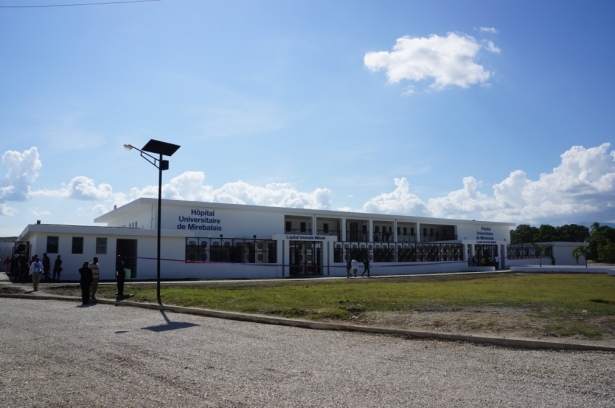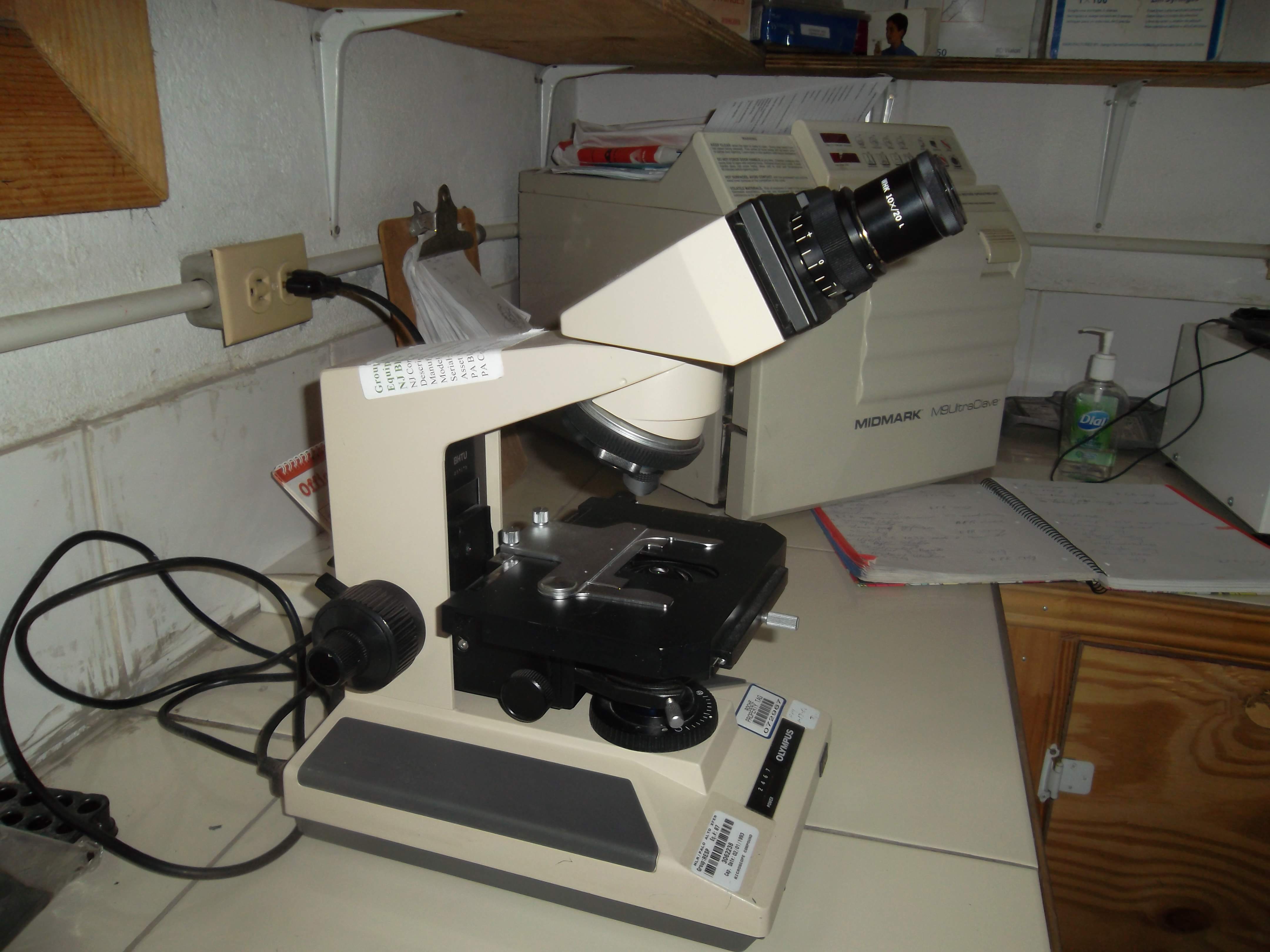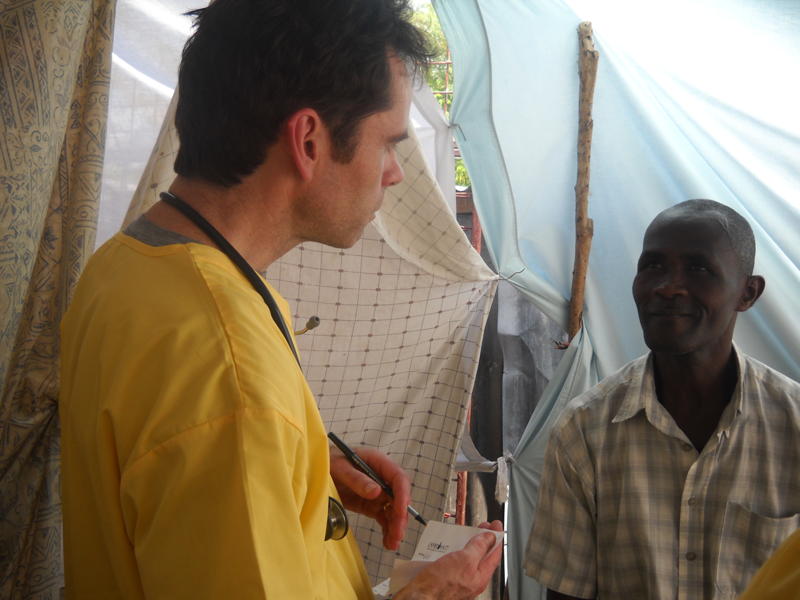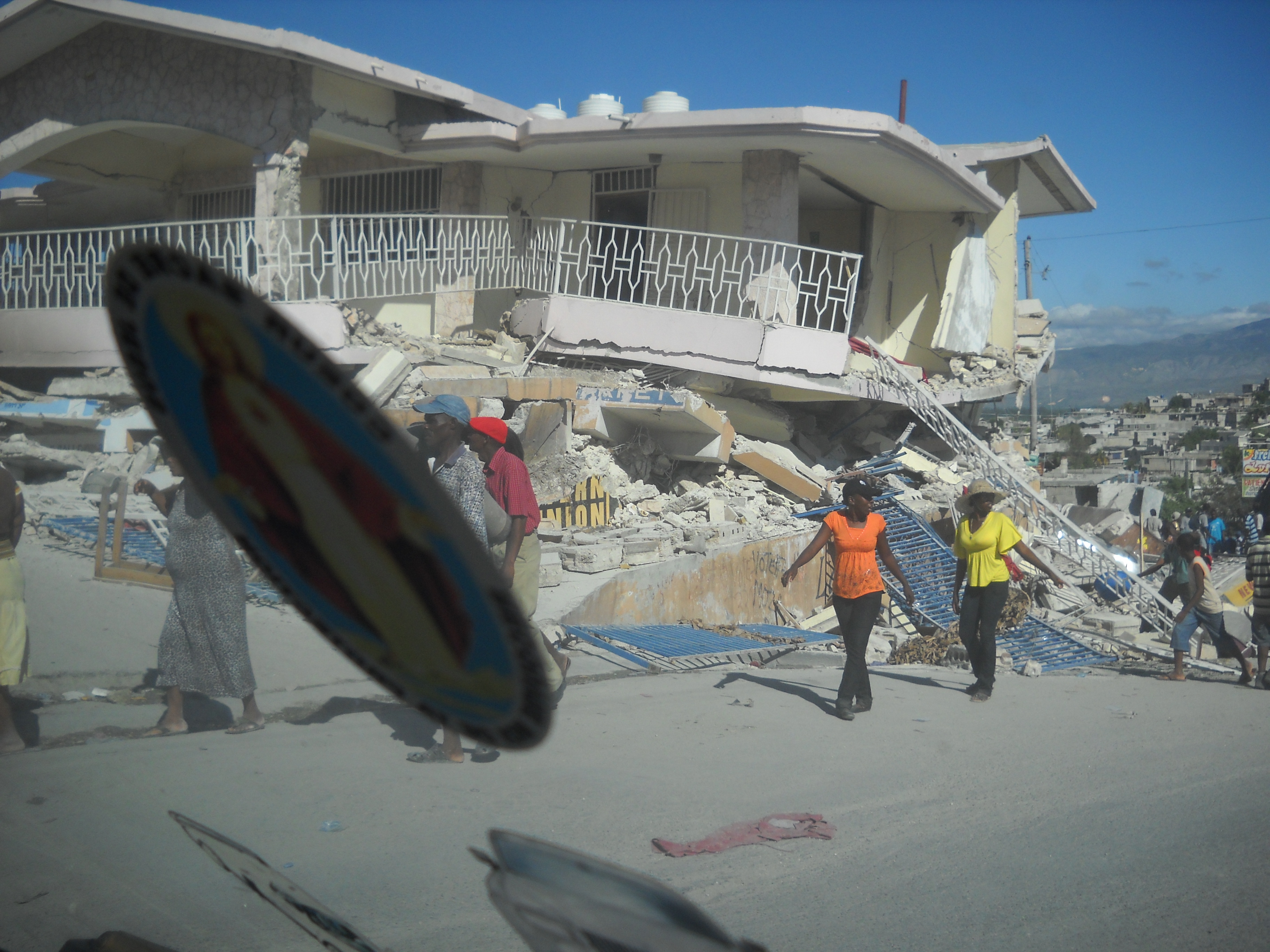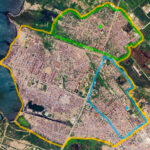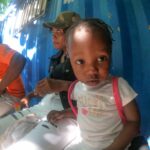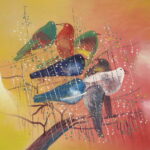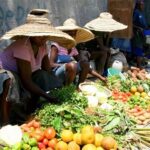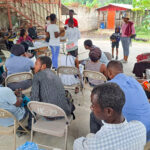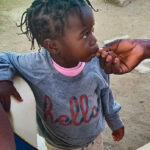The day started like a typical Haitian Sunday… relaxed. I had made plans the day before with Junior to catch a ride to St Damien’s hospital in Tabarre. Fr Rick lives there and I wanted to meet up with him and to go to Mass. He’s been a great mentor and friend for me in my Haitian journey. When I spoke with Fr Rick by phone the night before, he told me that Mass would be in the evening. Unusual for him to have a Sunday evening Mass St Damien’s . I knew things must have been busy.
“Can I give you a hand tomorrow?”
“Sure, we could use the help. Come on by and speak to Conan.”
I awoke early, as is my norm there, sleeping and arising in sync with the sun, particularly when there is no electricity. I have often been struck by how quickly I do so when there is no power. It makes perfect sense of course, and yet in 2011 the injustice of that scenario is not lost on me. The news reports about how electricity shortages in Baghdad make life tough. In Haiti that’s the norm. How can people study when there is no light, ne expect advancement when hours are spent on daily travel, on water and food procurement? As a kid I remember hearing once that Abraham Lincoln knew the importance of studying, and so he would do so by candlelight. Over a century later we still accept such an approach.
As we were getting ready to go, Junior went out to the truck and found the front passenger side tire flat. The day before, I had paid to have that same tire repaired. It was impressive to watch the guy jack up the truck, remove the tire, then using what looked like a wheel jack from my parents’ old Country Squire station wagon, and manually remove the tire from the wheel. Except he didn’t use the jack part. Rather he swung the 3’ long steel upright pole, lodging the base of it between the rubber tire and the rim. It can’t be too good for either part, but such is the common way it’s done. Next the inner tube is removed and the hole located by squeezing, listening for the hissing leak. The hole is patched using rubber, heated over a wood fire and allowed to cool. The process is vintage Haitian—simple, logical, exactly how I fixed flats on my old Schwinn. The result is too, unfortunately. Cheap materials, cheaply repaired on the street just don’t have a great track record, and so our predicament was not unexpected.
Junior told me that we would not be able to repair the tire until the next day. I was not happy, and the familiar frustration of Haiti washed over me like an unwelcomed kiss planted by an ancient aunt on an eight year old boy. The trick in navigating Haiti without having a stroke is to stay cool when the inevitable happens – like getting a flat on the worst roads you’ve ever seen – and to know to get pissed off when you need to, not settling for the status quo when better results are within reach. It’s a delicate balance that I struggle with on a regular basis.
I asked the driver how we could fix the problem and he looked behind me. As luck would have it, his own vehicle , a Montero SUV, is the same make that our organization, Lamp for Haiti, uses. His truck has four flat tires not because he keeps going back to the same tire repair guy, but because he hasn’t driven the vehicle in months. He simply swapped out the wheels, pumped it up and we were in business. We arrived in Tabarre a little later than I had planned, but not too far off the mark.
When I walked onto the grounds of the hospital, I was told by the guard that Fr Rick was in church. I walked the 100 yards toward the chapel, but did an about face after seeing a coffin in the center aisle, and hearing sobs exude outside. I walked to the side of the chapel and ran into my friend Conan.
Conan, an American, should be in a movie. He is a nurse by training, and he used to help run an Emergency Department in the States. He works like a dog seven days a week. His pay is food and a room. His red hair and fair eyes belie a propensity for skin cancer that makes my dermatologist wife cringe even talking about him. On this day he is wearing mirrored wrap-around shades, and a blue bandana as a head cover.
“Hi Jim, can you work tonight?” is his greeting. He disposed of the formalities like “Hi how have you been?” and “Good to see you” long ago. I am happy to be on that level of comradeship with him. Conan is about the work. His work ethic is impressive. It’s an elite group that is so dedicated to a cause. In that group is also Fr Rick, a physician and Catholic priest, who works even more nonstop on behalf of the poor.
Among other hats he wears at the hospital, Conan is responsible for staffing the cholera tents with doctors, nurses, and ancillary workers. We share stories about the cholera patients we have seen over the last few days, and he is exhausted in his rendition.
“Sure I can work tonght.”
“How long? When can you start?”
“I have to be at our clinic tomorrow at 7am. I’ll work all day and night if you want. You tell me where.”
“Ok good.” That’s all you get. Nothing more. No, these guys work like that all the time. I neither expect nor want any other response.
The funeral has ended in the chapel, and the mother of the boy who died is running around, sobbing uncontrollably. Fr Rick is headed towards us, but is stopped by the mother, who literally throws herself into his arms. She asks him where her son will be buried, since he died from cholera and the general hospital morgue won’t accept the body. He speaks softly to her in Creole. I can’t hear what he tells her.
Speaking in his Canadian-Connecticut-Haitian accent, Pere Rick says to me “Oh jim. Nice to see you. Are you seeing a lot of cholera at your clinic? We have to bring this body over to be cremated. Can you give us a hand?” He too does not waste his words. The three of us load the cheap plywood casket onto a truck and drive to the crematorium. We unload the cargo, and I hold open the iron gates as they deliver the coffin. The all too familiar smell of death is present. The oven is working on one body already, but other lifeless ones wait on tables nearby. The smell, I know it as that of anaerobes, bacteria that grow well in nonliving or poorly oxygenated tissue. It is akin to the smell of dirty socks from a bunch of teenage boys, left in a pile for a week. I am instantly transported back to a side street I walked down after the earthquake ten months ago. Then, as now, bodies were decomposing, and the exuded odor was harsh. I recall reading somewhere that scent memories are imprinted deeply in the brain and some of the most difficult to forget. Unfortunately I am finding this all too accurate.
After dropping off the body, we go over to a storage area to collect some wooden pallets. We have to build a tower to put a water tank on. The plastic container, about 1000 gallons in capacity, is being used to supply water for cleaning in the cholera treatment area. Gravity will allow the water to be distributed to several different places. Water is key on a normal day in Haiti. During a cholera epidemic, it becomes the Rosetta Stone.
We load the pallets onto the truck. I try not to let on that the giant bugs jumping out from the crevices of the pallets really do gross me out. We drove over to the cholera treatment area about four football fields away.
Conan tells me that I will be working triage, and also the treatment tents. Currently there are three large tents, like the kind my parents rented for my sister’s wedding reception in our backyard. The only dancing though, is by the nurses who are working their butts off, trying to keep up with the volume of patients and their needs. “Ok, no problem” I tell him, even though I have never taken care of a cholera patient in my life before this week. I read a lot about the disease in the past two weeks, and attended a meeting with the Lamp medical team the day before, sponsored by the Haitian Ministry of Health, for NGO’s working with cholera patients. I guess I’m as good as they’re going to get today.
Conan tells me that I’ll work until about 11pm. That will give the American guy, Jeff, an ER physician from Ohio, a few extra hours of rest. No problem. It’s just past noon.
I relieve a young and very pleasant Haitian doctor, a woman, who gives me a detailed sign out. “This man has diarrhea and vomiting. We are hydrating him with IV fluids, and we will give him antibiotics – just one dose. This woman has diarrhea and vomiting. We are giving her IV hydration and antibiotics- just one dose of antibiotics, you understand? This baby is vomiting and has diarrhea. Baby needs hydration and antibiotics, just one dose, you understand ?” And so on went the sign out. After about the tenth patient I asked her to point out the ones who were not vomiting with diarrhea. Of the 40 or so patients, none fit that description. “Tout moun genye diarya ak vomis.” We cut to the chase, and she bade me bon chance.
After a few hours, I had my mojo on. Having worked as a doctor in a level I trauma center in New York City for six years has some advantages to it, and one is confidence. A PhD student in public health was there, whose area of interest is cholera. “Perfect,” I tell her. “You can do discharge training of patients. We need to educate them on eating and cleaning and toileting.”
I schmoozed a couple of nurses early on. My ER experience had taught me that if you don’t do that first, you’re dead. The nurses are the hub of the wheel in the ER. Doctors maybe driving the car, but the vehicle won’t move an inch without them. A nursing friend once told me that I could charm the skin off a snake when it came to those situations, a talent I am happy to have, because the team has to get along to have a chance at being effective, especially in the face of catastrophe.
The cholera epidemic in Haiti is a catastrophe.
Patients coming in were being triaged and treated appropriately. I even was able to discharge a few patients, and they received discharge instructions, in Creole.
About 4pm, Fr Rick asked if I could head out to Warf Jeremie. I had been there a few times before. It is a place in Cite Soleil, not far from Bwa Nef where our Lamp clinic is located. Warf Jeremia too is poor, and densely packed with people. There is a clinic there, run by an Italian nun, he told me. “The clinic needs to send some patients to St Damien’s , and they need a doctor to tell which ones are the worst. Bring the generator and some gas, since they don’t have electricity and it’ll be dark soon. Win can drive, and he’ll bring Allain with him too.” And off we went. There were five of us, all blan, the Creole expression for white people.
We drove along Route Nationale, on the outskirts of Cite Soleil. Win was kind enough to bring along a plate of food for me, and I ate in the back seat. The food tasted delicious, and after the first bite I remembered I had not eaten all day. I was hungry, and practically ate the plate on which it was served.
After about 20 minutes in the truck we turned right onto the road leading to Warf Jeremie. It was dark now, and the way was lit up by headlights from the occasional vehicle, and by the small cooking fires on the side of the road. Tin shacks, held together by rust, dogs barking, smoke spewing from in front of homes, children sitting naked on the ground. Horns honking. I was looking for Mel Gibson in Road Warrior garb to come racing by on his motorcycle, but this scene was even more distressing than anything Hollywood had yet offered. I asked myself “what could be worse than to live like this?” I was about to find out.
We arrived at the front of the clinic in silence.
On entering the dark building, we were greeted by Sr Michaella, an Italian nun, maybe 50 years old. She was happy to see us for sure. The clinic was officially to open in about 2 weeks. She had arranged for medical staff to start at that time, but then came the epidemic of cholera. Like most disasters, this one didn’t read the schedule and came inconveniently early. People in the neighborhood began coming to the clinic looking for help. “I could not turn them away” she told me, and soon the beds were full. There was a team from another medical NGO who were awaiting clearance from the Ministry of Health to work at a state hospital, and fortunately they would be able to assist. “But they told me yesterday they would not come today since it is Sunday and they needed a day off. So it is just me and my boys. We have been working nonstop since very early this morning. I have no energy left. What do you think I should do?”
Win and I looked at each other. We came to take the worst of the patients and so we started to go around triaging patients. Very quickly, I had to assess each one, and decide who would be transferred back to the hospital in Tabarre. Sister Michaella had a tap-tap available and so we figured we could transport five patients. Someone started the generator, and there was a dim light throughout the building. It was worse than I could have imagined. People were crowded into that place. Vomiting and diarrhea was rampant. It was a horrible sight to see such suffering. It was worse to smell. An old woman was sitting on a red bucket, her flowered dress pulled up around her waist, with diarrhea. She hadn’t the strength to sit up, and she rested her head on an adjacent cot. Babies not crying, dry mouthed. Young men , obviously from the community, moved about with purpose, looking for IV’s not functioning, assisting new patients to cots or open floor space. I asked Sister Michaella if she needed me to stay. “If you would, yes. Otherwise we will have to send people home. For the last two days we arrived in the morning and found four dead bodies on the steps, waiting for us. ”
Win heard my conversation, and said “Jim, if we take the worst cases back then you wouldn’t have to stay. “ He sensed my nervousness in making the offer. Cite Soleil is a notoriously tough place under the best of circumstances. With the upcoming elections, it had become a lot more risky, as local gangs backed by different candidates, tussled. The wrong comment could be big trouble. He went on… “We don’t know how long the gas will last in the generator. You won’t have any nurses. I don’t know how long the IV fluids will last.”
“You’re right.” It was a bad idea. After all, we’ll be taking the five worst cases, right? Then with a little luck people can go home and come back tomorrow morning for more treatment. Also, God knows I didn’t want to spend the night in Cite Soleil alone. Though I’d worked regularly in Bwa Nef for years, it had always been during the daylight hours, and always with close confidants. I told Sister my reasoning. She understood and assured me it was okay. She squeezed my hand and thanked me for coming to help those people we would be taking back to St Damien’s. She turned to continue her work, and I went about helping to load up the patients.
As we were getting the last patient ready, I turned to Win. “I’m staying. I can’t leave these people. Look at them. There’s no one else to do it.” He called on his cellphone back to Fr Rick, and we got the OK. I spoke to Sr Michaella again, and I thought she would kiss me. I didn’t know how I would make it through the night. In a weird way, I was reminded of when I used to be an ER doctor in the West Village of Manhattan, starting a shift on the night of the Halloween parade. You knew it would be crazy and exhausting, but you would get through it. I didn’t linger on the obvious — in the ER we had lights, running water, security, professional nurses and doctors, and every modern medical test at our fingertips.
As Win and the others were readying to leave, Sr Michaella told me that I would have some help. There was a group of five nuns and priests from Brazil who happened to be living in some tents nearby. They had come recently to minister to the poor. She introduced me to Sister Cacilda.
Sister Cacilda smiled so radiantly and gently, it was a gift from above. She told me in broken English that she and the others would help me, and that together with the help of the young men from the community, and “most importantah” – she pointed up – “with His help. We will do this.” She beamed with faith. I felt lifted up by her courage. Here I was, a relative veteran of the streets of Cite Soleil, a seasoned doctor who worked through 9/11 in NYC. I thought I’d seen it all. And yet it was a nun who had just recently arrived in Haiti, and was living in a tent in one of the worst places one could imagine who became a conduit of holiness and strength. Amazing.
As the night wore on, the vomiting and diarrhea continued, and more patients came. I had no idea how long the fuel would keep the generator going. Most patients needed intravenous hydration, and lots of it. Finding a vein in a dehydrated body can be really tough. I was particularly happy when I finally was able to get a line in the old woman with the flower dress. She was close to death, but the hydration worked.
Sister Cacilda never stopped smiling. She asked me if I would like something to eat, and though I hadn’t thought of it, I realized that I felt ravenous. I answered yes. She spoke in Portugese to one of the young priests, and he brought me a mango and a chunk of peanut butter. I think it’s one of the best things I have ever tasted.
At about four in the morning, I was completely exhausted. I told Sr Cacilda that I had to lie down for one hour. I crawled into a cot in the back, and lay down. The room started spinning, and I thought I would puke. “Oh my God. I can’t get sick.” I said aloud to the empty room. I got up and used the bathroom, and didn’t vomit. I crawled back into the cot and somehow woke up exactly one hour later.
At six o’clock I was had just finished putting in a line into a child who was severely dehydrated. As I looked up, the sun was just coming up above the horizon. On cue, the generator started to sputter, the familiar sound it makes when running out of gas. It had lasted all night as we needed it to do.
The daytime medical team began arriving, doctors, and nurses and the others. Sister Michaella introduced to me some of her “boys”, whom I assumed would be young men, maybe in their late teens or twenties. But they were boys, literally about twelve years old, assisting the sick, working tirelessly. Once again the Haitians impress me.
Sister Cacilda and I exchanged numbers and email. I am sure we will work together again, and again it will be my privilege. We proudly noted pa mori – all our patients survived the night.
A driver came to pick me and the generator up, to go back to St Damien’s . I needed a shower, and some sleep. Getting out of the truck the first person I saw was Conan. “Oh good. Jim. Can you work tonight?”

